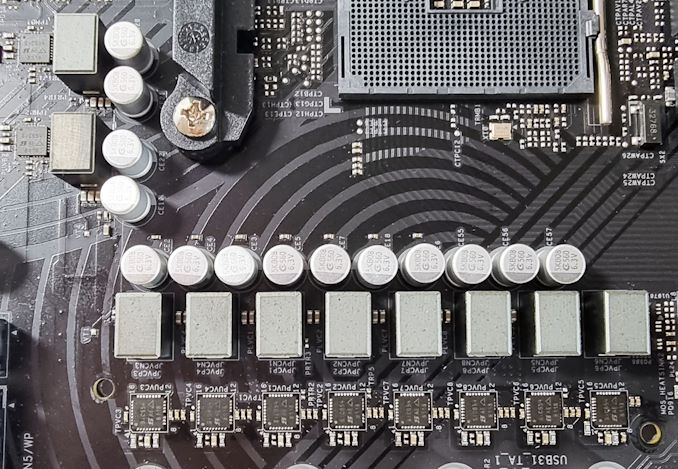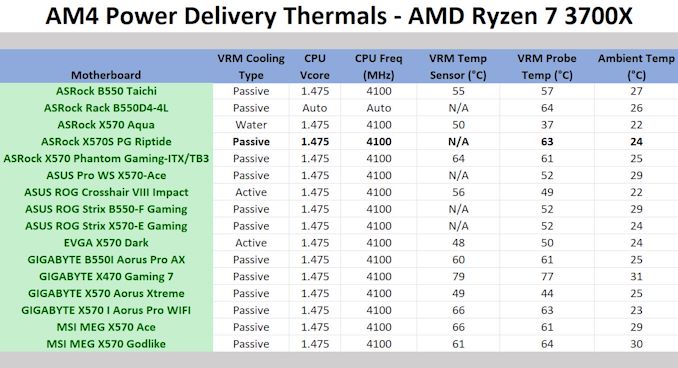The ASRock X570S PG Riptide Motherboard Review: A Wave of PCIe 4.0 Support on A Budget
by Gavin Bonshor on October 22, 2021 9:00 AM ESTPower Delivery Thermal Analysis
One of the most requested elements of our motherboard reviews revolves around the power delivery and its componentry. Aside from the quality of the components and its capability for overclocking to push out higher clock speeds which in turn improves performance, is the thermal capability of the cooling solutions implemented by manufacturers. While almost always fine for users running processors at default settings, the cooling capability of the VRMs isn't something that users should worry too much about, but for those looking to squeeze out extra performance from the CPU via overclocking, this puts extra pressure on the power delivery and in turn, generates extra heat. This is why more premium models often include heatsinks on its models with better cooling designs, heftier chunks of metal, and in some cases, even with water blocks.

The 10-phase (8+2) power delivery operating at 4+2 on the ASRock X570S PG Riptide
Testing Methodology
Out method of testing out if the power delivery and its heatsink are effective at dissipating heat, is by running an intensely heavy CPU workload for a prolonged method of time. We apply an overclock which is deemed safe and at the maximum that the silicon on our AMD Ryzen 7 3700X processor allows. We then run the Prime95 with AVX2 enabled under a torture test for an hour at the maximum stable overclock we can which puts insane pressure on the processor. We collect our data via three different methods which include the following:
- Taking a thermal image from a birds-eye view after an hour with a Flir Pro thermal imaging camera
- Securing two probes on to the rear of the PCB, right underneath CPU VCore section of the power delivery for better parity in case the first probe reports a faulty reading
- Taking a reading of the VRM temperature from the sensor reading within the HWInfo monitoring application
The reason for using three different methods is that some sensors can read inaccurate temperatures, which can give very erratic results for users looking to gauge whether an overclock is too much pressure for the power delivery handle. With using a probe on the rear, it can also show the efficiency of the power stages and heatsinks as a wide margin between the probe and sensor temperature can show that the heatsink is dissipating heat and that the design is working, or that the internal sensor is massively wrong. To ensure our probe was accurate before testing, I binned 10 and selected the most accurate (within 1c of the actual temperature) for better parity in our testing.
For thermal image, we use a Flir One camera as it gives a good indication of where the heat is generated around the socket area, as some designs use different configurations and an evenly spread power delivery with good components will usually generate less heat. Manufacturers who use inefficient heatsinks and cheap out on power delivery components should run hotter than those who have invested. Of course, a $700 flagship motherboard is likely to outperform a cheaper $100 model under the same testing conditions, but it is still worth testing to see which vendors are doing things correctly.
Thermal Analysis Results

We measured 57.7°C on the hottest part of the CPU socket during our testing
The ASRock X570S PG Riptide is using a 10-phase power delivery, which is split into an 8-phase design for the CPU VCore, and a 2-phase setup for the SoC. The CPU section is using eight Vishay SIC654 50 A power stages operating with two UPI UP1911R smart PWM doublers that are quadrupling the power stages in a 4+0 configuration. The SoC is using two independent Vishay SIC654 50 A power stages, with a UPI UP9595S PWM controller operating in 4+2 mode. Cooling the power delivery is a single heatsink that doubles up as the board's rear panel cover. It's not very weighty and relies on good passive airflow over a large plate over the top of the heatsink.
Looking at how the ASRock X570S PG Riptide performed in our thermal VRM testing, it did pretty well considering it's an entry-level to mid-ranged X570(S) model. We measured a temperature of 63°C from our K-type thermocouple and got a reading of 57.7°C from the hottest part of the CPU socket area when using our FLIR thermal imaging camera. Unfortunately, the PG Riptide doesn't use an integrated VRM thermal sensor.
Comparing the PG Riptide to other AM4 models we've previously tested, it does sit near the warmer boards we've tested, but it's still well within specifications and performs as expected given the price point the board sits at.











39 Comments
View All Comments
Calin - Monday, October 25, 2021 - link
And if your soldered-on SSD breaks, you need to replace the entire device.I'm using an HP 8200 (I think) with third generation i3 and - originally - a 320 (I think) GB hdd.
It runs with 3TB plus 1TB plus one 120GB SSD.
With 320GB only of storage, I would have thrown it long ago.
Robberbaron12 - Wednesday, October 27, 2021 - link
I expect this is the future for "mobile" CPUs, a mega SOC with Ram and a SSD soldered on and then everything else connected over PCI-EPerson5e9 - Friday, October 22, 2021 - link
Can someone, preferably asrock or gigabyte, please make an x570s m-atx. Lots of people would buy one in this underserved category for the smaller size and greater expansion (RAM and slots). Thanks!TheinsanegamerN - Saturday, October 23, 2021 - link
Why? B550 already exists, so you get PCIe 4.0 for a M.2 SSD and the GPU. You dont get more RAM slots with X570 VS B550.Is having 4.0x1 slots that important?
Calin - Monday, October 25, 2021 - link
4.0 1x slots might be more valuable than 4.0 x16 slots, as most computers won't come even close to filling up a 3.0 x16 slot.ipkh - Sunday, October 24, 2021 - link
What's with the crappy Tidepods++ graphic for?It's rather crass and shouldn't be there as it has nothing to do with the article.
Harry_Wild - Sunday, October 31, 2021 - link
All these board manufacturers should concentrate on the itx size motherboards for the mini PC cases, 12" X 7" X 10". Boards are 6.7" X 6.7" in size!atragorn - Sunday, November 14, 2021 - link
If there was sufficient demand they would be doing so already. Most people view these things colored by their own needs or desires, What I want or need is what everyone wants/needs. Which is simply not true. If most people wanted ITX systems the store shelves would be FULL of ITX systems.Whats on the shelves is what most people want/need. When that changes so will they. They do a lot of research to find out what they should be making. Hint its what people will buy.
dailyprimenews - Tuesday, December 28, 2021 - link
https://todayprimenews.com/https://todayprimenews.com/world-news/
https://todayprimenews.com/sports-news/